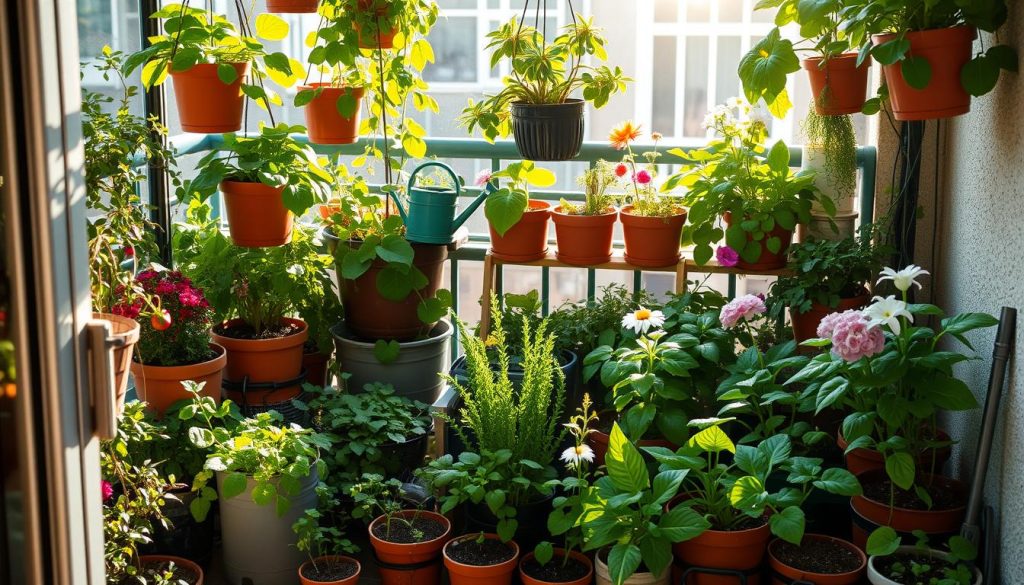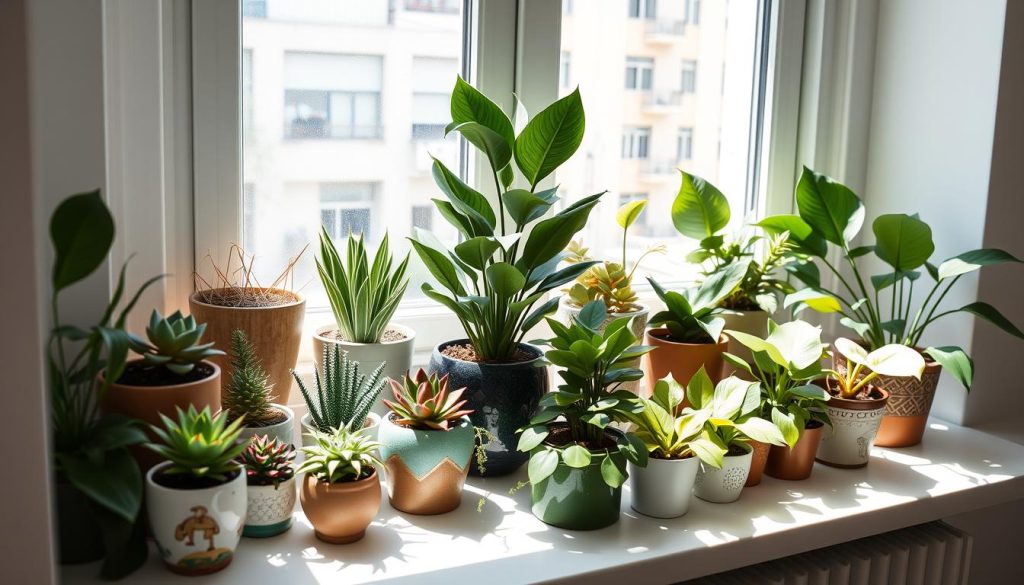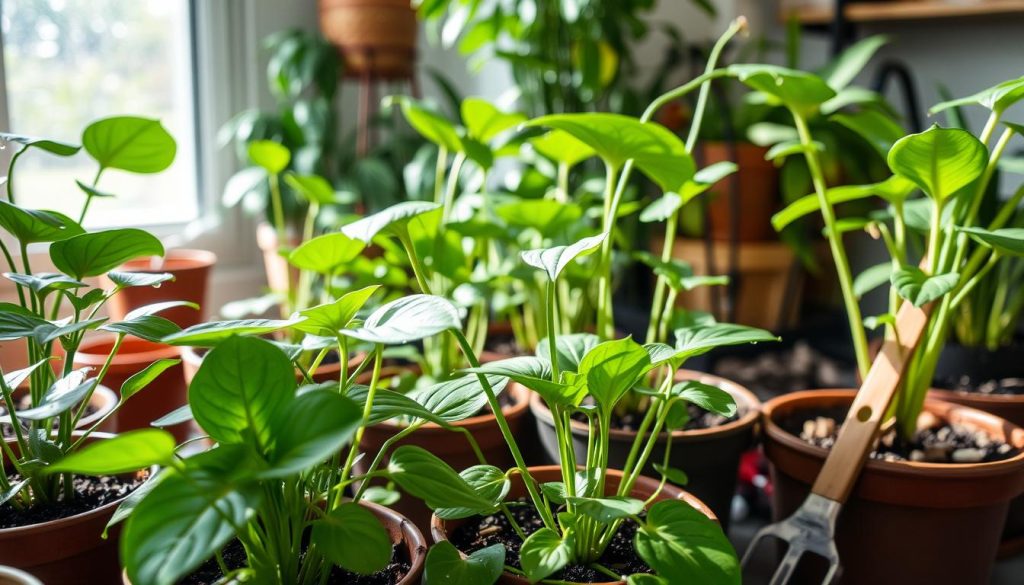Turn your small living area into a lush urban garden. You can grow plants, herbs, fruits, and veggies, even with little space. Enjoy the fun of indoor gardening and the perks of growing your own food, all in a small area.
To make the most of your small space, plan carefully. Think about sunlight, container weight, and soil needs for a healthy garden. Begin with a few containers and learn as you go, exploring the magic of indoor gardening.

Key Takeaways
- Use small spots like balconies, windowsills, and shelves for your indoor garden.
- Check how much sunlight you have and pick plants that do well in it.
- Choose light containers and good potting mix for a successful garden.
- Try vertical gardening and smart space use to get the most out of your area.
- Water and feed your plants regularly to keep them healthy and productive.
Understanding Small-Space Gardening Fundamentals
Starting an indoor garden can be very rewarding, even in small spaces. Studies show gardeners live up to 14 years longer. This is because gardening is good for both physical and mental health. First, figure out how much space you have. This could be a sunny balcony, a big windowsill, or a cozy corner in your apartment.
Benefits of Indoor Plant Growing
Indoor gardening has many benefits. It improves air quality, reduces stress, and brings calm. Adding plants to your home can make it more peaceful and healthy.
Basic Requirements for Success
To make your indoor plants thrive, focus on a few key things. You need good soil, enough water, and the right amount of light. Pick plants that fit your family’s needs and what you want to use them for.
Space Assessment Guidelines
- Check how much natural sunlight your home gets. This will help you choose the right plants.
- Think about using balconies, windowsills, or small backyard areas to grow more plants.
- Look at your space’s layout and size to figure out the best spot for your plants.
Learning about small-space gardening can help you enjoy growing your own indoor garden. You can do this even if your living space is small.
Essential Equipment and Materials
Starting an apartment garden? You’ll need the right tools and supplies. Get quality containers, potting soil, and organic fertilizers. These will help your plants grow well in your small space.
For apartment gardeners, a sturdy trowel, a 3- or 4-prong cultivator, and a handheld hoe are key. They make caring for your plants and soil easy. Wear comfy shoes and a sun hat to protect yourself while gardening.
- Containers: Pick a range of pots, planters, and hanging baskets for different plants and sizes.
- Potting Supplies: Get a top-notch potting mix for containers and raised beds. Organic compost and fertilizers will feed your plants.
- Grow Lights: If your area gets little natural light, use adjustable grow lights. They ensure your plants get enough light.
Keep your gardening tools organized with a small storage solution. A wall-mounted rack or a portable tool caddy works great. With the right gear, your apartment garden will flourish.
Choosing the Right Location for Your Garden
When you garden indoors, where you put your plants matters a lot. The indoor light conditions, temperature control, and plant placement are key to your plants’ success.
Light Requirements
Most plants need 6-8 hours of direct sunlight a day to grow well. If your place doesn’t get enough sunlight, think about using grow lights. Plants that don’t need much light, like philodendrons and ZZ plants, can do well in low-light spots.
Temperature Considerations
The best temperature for indoor plants is between 65-75°F (18-24°C). Don’t put your plants where it’s too hot or cold, like near air vents or drafty windows. Keeping the temperature steady is important for your plants’ health.
Ventilation Needs
- Good airflow is vital for indoor plants to grow well.
- Put your plants in spots with natural air flow, like near windows or use a small fan.
- Stay away from places that are too still, as they can cause mold, pests, and slow growth.
Think about the indoor light conditions, temperature control, and plant placement in your apartment. This will help your indoor garden thrive.
Soil and Potting Mix Essentials
Choosing the right soil is key for apartment gardening. Don’t use regular garden soil. Instead, pick a potting mix made for containers. This mix helps oxygen and water move well, keeping roots healthy.
Think about getting an organic potting mix or making your own. Stay away from potting soil for landscapes. It’s not good for indoor plants. A good potting mix gives your plants the nutrients they need to grow well in small spaces.
- Potting soil allows for efficient circulation of oxygen and water
- Organic potting mix or homemade blends are preferred over landscape soil
- Potting mixes provide the necessary soil nutrients for indoor plants
Choosing the right potting mix is vital for a successful apartment garden. A high-quality, well-draining potting soil helps your plants grow well. Even with little space, you can still have a great harvest.
Container Selection and Sizing
Choosing the right plant pots and containers is key for apartment gardening. The size and type of container are crucial for success. Let’s look at what to consider for the perfect plant pots and drainage solutions.
Types of Containers
There are many plant pots and containers to choose from. You can pick from classic plastic to rustic terracotta and stylish ceramic. Think about weight, durability, and looks when picking.
Terracotta clay pots give a natural look. Glazed ceramic containers offer many colors and designs. Plastic pots are affordable, light, and come in many styles.
Drainage Requirements
Good drainage is key for healthy plants in container gardening. Make sure your pots have enough holes for water to drain. You can also add gravel or stones at the bottom for better drainage.
Using saucers under your pots helps keep moisture and protects surfaces from water damage.
Weight Considerations
Think about the weight of your plant pots, especially if you’re gardening on a balcony. Choose light materials like plastic for easy moving. Heavier containers like concrete or stone are best for fixed spots.
The container size should match your plants’ mature size. Bigger pots are good for larger plants and hold more soil. Smaller pots are better for compact or trailing plants. With the right container types, drainage, and weight, you can have a thriving garden.
Apartment Gardening: Smart Plant Selection
Choosing the right plants is key for apartment gardening. Look for plants that do well in containers and take up little space. Indoor herbs are great because they add flavor, clean the air, and make you feel better.
Begin with herbs like mint, chives, parsley, lavender, basil, and thyme. These plants are easy to care for and make your space smell good. For color and variety, try growing salad greens, dwarf tomatoes, chili peppers, Meyer lemons, and strawberries.
- Mint: Refreshing and versatile, mint thrives in containers and can be used in teas, cocktails, and various dishes.
- Chives: Delicate onion-flavored chives add flavor to soups, omelets, and baked potatoes.
- Parsley: A staple herb that’s rich in nutrients and enhances the flavor of many savory recipes.
- Lavender: Not only does lavender provide a calming scent, but it can also be used in DIY beauty products.
- Basil: Perfect for making pesto or adding to tomato-based dishes, basil is a must-have indoor herb.
- Thyme: Earthy and aromatic, thyme pairs well with meats, vegetables, and stews.
For a diverse indoor garden, try compact fruits and vegetables. Dwarf tomato plants, chili peppers, and Meyer lemon trees grow well in containers. They give you fresh food right in your home.

When picking plants for your apartment, think about what they need to grow. Light, temperature, and water are important. With the right plants, your indoor space can become a green, productive, and beautiful place.
Vertical Growing Solutions
Urban gardeners can make the most of their space with vertical gardening. Using vertical structures or containers lets you grow many plants without using much floor space. This method saves room and is perfect for tight urban areas where regular gardening is hard.
Wall-Mounted Systems
Wall-mounted planters are great for vertical gardening. They let you create living walls or vertical gardens by attaching them to the wall. This is perfect for growing herbs, small veggies, and trailing plants, adding greenery to your space.
Hanging Gardens
Hanging baskets and planters are also great for vertical gardening. Hanging plants from the ceiling or wall-mounted brackets makes a beautiful display and saves floor space. Plants like cucumbers, tomatoes, and squash do well in hanging gardens, giving you a lot of harvest in a small area.
Space-Saving Trellises
Trellises, obelisks, and other vertical supports are key for growing vining crops like pole beans and peas in small areas. They help plants grow up, saving space and making the most of your vertical area.
Using vertical gardening can turn even the smallest spaces into productive and beautiful gardens. By adding wall-mounted systems, hanging gardens, and space-saving trellises, you can make the most of your urban garden. Enjoy a rich harvest in a small area.
Water Management and Humidity Control
Keeping the right amount of water and humidity is key for your indoor garden. A consistent watering schedule helps your plants get the moisture they need. For container plants, check the soil moisture by poking your finger 1-2 inches deep.
To boost humidity, try misting or using water trays. It’s also vital to have good drainage to avoid water damage. By managing water and humidity well, your plants will grow strong and healthy.
- Maintain a consistent watering schedule, adjusting as needed based on soil moisture levels
- Increase humidity for indoor plants through misting or using water trays
- Ensure proper drainage to prevent water damage to surfaces
- Monitor plant health and adjust watering and humidity levels accordingly
Success in indoor gardening comes from balancing watering, moisture, and hydration. By paying close attention to these, you can create a lush oasis at home. This oasis will bring you joy and fresh produce.
Fertilizing and Nutrition Guidelines
Keeping your apartment garden well-nourished is key to its success. Water-soluble fertilizers are easy to use during watering. But, it’s important to tailor feeding schedules for each plant. Organic fertilizers and composting can enrich your soil and boost plant growth.
Organic Feeding Options
Organic fertilizers like compost or vermicompost are great for apartment gardeners. They not only feed your plants but also enhance soil quality. Turning food scraps and yard waste into compost can be a valuable addition to your container gardens.
Fertilizing Schedule
- Watch how your plants grow and adjust feeding times as needed. Some plants need more food, while others do well with less.
- Choose a balanced, water-soluble fertilizer and follow the instructions for how much and when to apply.
- Add slow-release organic fertilizers to your potting mix for a steady nutrient supply all season.
- Change your fertilizing routine based on your potting mix and the needs of your plants.
By following these organic fertilizing tips, your apartment garden will flourish. Healthy, lush plants are the result of proper feeding in small-space gardening.
Growing Herbs and Vegetables Indoors
In today’s world, even those living in apartments can grow their own food. Indoor herb gardens and growing vegetables in apartments let you have fresh, homegrown produce. You can grow herbs like cilantro, chives, basil, rosemary, thyme, and mint. Also, vegetables like lettuce, arugula, cherry tomatoes, and peppers are great options.
Use your windowsills, countertops, or a special indoor growing area for your plants. With the right care, you can pick fresh food right from your home. Adding microgreens to your garden is a smart choice for quick and healthy food.
- Grow a variety of herbs like cilantro, chives, basil, rosemary, thyme, and mint indoors
- Cultivate vegetables such as lettuce, arugula, cherry tomatoes, and peppers in your apartment
- Utilize countertop gardens, windowsills, or dedicated indoor growing stations for easy access to fresh produce
- Explore the benefits of growing microgreens for a fast and nutrient-dense harvest
With a bit of creativity and the right care, you can turn your small space into a lush indoor herb garden and apartment vegetable paradise. This way, you’ll always have fresh, tasty ingredients ready for you.
Maximizing Balcony and Windowsill Space
For apartment dwellers, using every inch for gardening is key. Creative solutions can turn small balconies and windowsills into lush gardens. You can create your own outdoor space with balcony gardens and window box arrangements.
Window Box Arrangements
Windowsill planters add color and life to your home. Choose a mix of vines, flowers, and herbs for stunning displays. Try combining petunias, lobelia, and herbs like basil or rosemary for a beautiful harvest.
Balcony Garden Layout
If you have a balcony, the gardening options are endless. Use vertical planters or hanging baskets to save floor space. Pick plants that don’t need much water and won’t be too heavy. With creativity, your balcony can become a green paradise.
Whether you have a small windowsill or a big balcony, the secret to great apartment gardening is using every inch. By adding windowsill planters and smart balcony garden designs, you can make your home a lush, green haven. Enjoy the beauty, smells, and tastes of your own garden.
Pest Management in Indoor Gardens
Keeping your indoor plants healthy means watching out for pests. Common pests include aphids, thrips, and mealybugs. They can harm your plants, causing damage and spreading diseases.
It’s important to check your plants often for pests. Look for signs like yellow leaves or insects. For small problems, you can remove pests by hand.
For bigger issues, try organic solutions like neem oil. These products are safe and work well against pests. Also, make sure your plants have good air flow and don’t get too wet.
Introducing beneficial insects, like ladybugs, can help control pests. Using a mix of prevention and organic control keeps your plants healthy.

Healthy plants are less likely to get pests. Choose the right plants for your space. Give them the right light, water, and care. A clean garden also helps keep pests away.
Seasonal Care and Maintenance
Keeping your indoor garden healthy means changing how you care for it with the seasons. In winter, when it’s cold and dry, plants might need more moisture. Make sure to turn your plants often to get them enough sunlight and help them grow evenly.
As the weather shifts, so should your watering and feeding habits. You’ll probably water more in summer since the soil dries out quicker. Feed your plants during their growing season with a balanced mix of nutrients.
- Increase humidity levels for plants during the dry winter months
- Rotate plants to ensure even sun exposure
- Adjust watering and fertilizing schedules to match seasonal changes
- Prune and harvest regularly to encourage continued growth
- Prepare for seasonal transitions by gradually acclimating plants
By paying attention to your plants’ seasonal needs, you can give them the best care. With the right tips and adjustments, your indoor garden will stay vibrant and healthy all year.
Conclusion
Apartment gardening brings many benefits, like growing your own food and improving your health. It turns small urban spaces into green oases. With the right planning and care, your apartment can show the strength of sustainable living.
Whether it’s a herb garden on your windowsill or a balcony oasis, the benefits are huge. You enjoy fresh produce and help the environment. This makes your community greener and more resilient.
Don’t shy away from the challenges of apartment gardening. There are many plants that thrive in small spaces. Your garden can become a peaceful place that nourishes you. With creativity and the right approach, your gardening journey will be rewarding. It will inspire others and highlight the importance of urban agriculture.